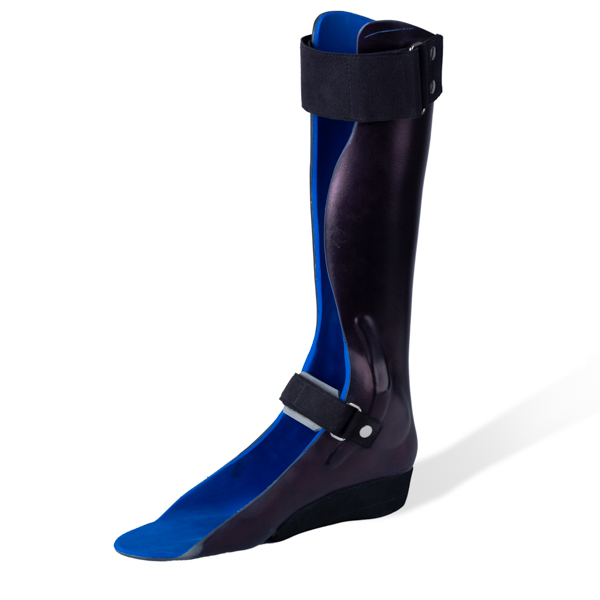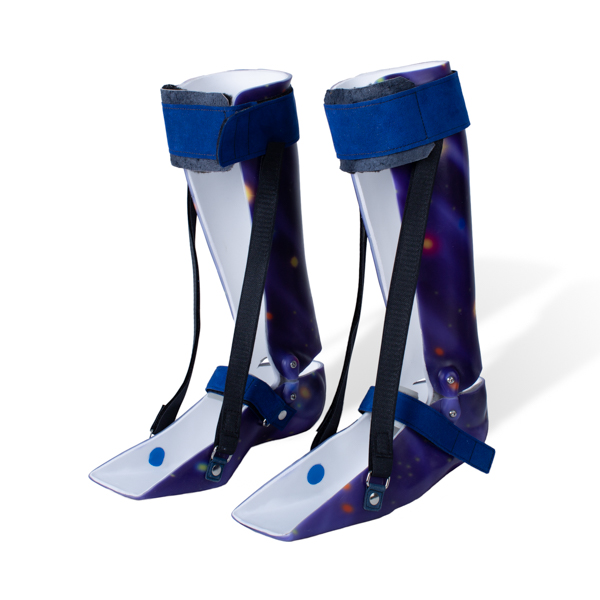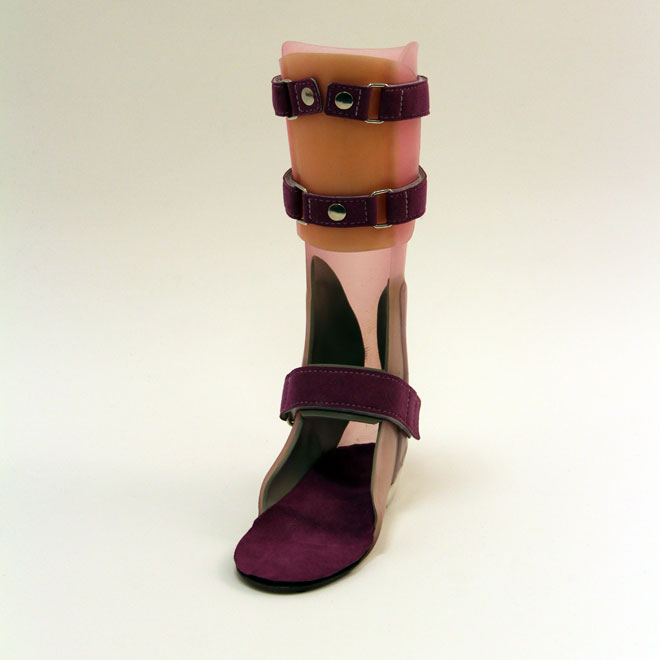As the name would suggest, an Ankle Foot Orthosis is an orthotic or brace that encompasses the ankle and foot. The objective is to control the position and movement of the ankle. AFOs are used to support weak limbs; they can also be used to immobilise the ankle and lower leg to correct drop foot. They are the most commonly used Orthoses.
Depending on the condition the London Orthotic Consultancy is treating, we can design them to be fixed at the ankle; this allows us to fine-tune a patient’s gait more effectively. Or they can hinge at the ankle to allow a limited range of movement in one plane.
Whatever kind of AFO is prescribed we fine-tune our bespoke orthotics; this is fundamental to ensuring optimum alignment and comfort. In 2015 a study of UK orthotists found that only 46% reported that tuning of AFOs was standard practice.
In a recent article in the Journal of Prosthetics and Orthotics - Elaine Owen argues that it is not a question of whether to tune or not as it should be standard practice and time should be allocated to the task by the orthotist.

Fixed AFO
Our clients want to be able to live an active lifestyle and exercise plays its part. Several patients approached us requesting we design them an AFO that could be worn in the shower, for swimming, for holiday. So we designed an AFO specifically for use in water.
Our waterproof AFOs have a removable liner and plastic components are used instead of metal to avoid rusting. Importantly they have a rubberised sole plate to allow safe weight-bearing without footwear. They allow for complete submersion in water and can be used to help transfer in and out of water for swimming and other water-based activities.
If you have any other specific requirements for your orthotic devices please speak with one of our orthotists to see if we can help. We are keen to be at the forefront of modern bespoke orthotic design and manufacture.
Making an Ankle Foot Orthosis in our on-site manufacturing workshop in Kingston
Our nighttime versions of our bespoke AFOs are very well padded as they are often worn without socks. They can be produced with adjustable ankle joints to encourage a greater range of movement as treatment progresses.
Plantar Fasciitis is one of the common conditions that can benefit from treatment with night splints; the fascia ligament is kept stretched while the patient sleeps. There are two main types of splint: the Dorsal and the Boot. The Dorsal has a hard plastic support that rides along the shin and top of the foot while the spine for the Boot’s brace is on the back of the leg and calf and runs under the foot.
There are advantages and disadvantages of both treatments; LOC’s specialist clinician will explain the pros and cons before prescribing treatment.

Sometimes called a Floor Reaction AFO, the GRAFO is used to control instabilities in the lower limb by maintaining proper alignment of limbs and controlling their motion. It is often used to try and maintain the length of the hamstring and prevent crouch gait which is one of the most prevalent movement disorders among children with cerebral palsy.
Crouch gait is characterised by excessive knee flexion during stance, this substantially increases the energy requirements of walking and, if not corrected, can lead to chronic knee pain and joint degeneration.
The GRAFO is complex to manufacture and in larger patients will require carbon fibre reinforcement.

An AFO is an Ankle Foot Orthosis which as the name would suggest encompasses the ankle and foot. The objective is to control the position and movement of the ankle. AFOs are used to support weak limbs; they can also be used to immobilise the ankle and lower leg to correct foot drop. When set up correctly they can also have a great influence on the knee and hip joints. They are the most commonly used Orthoses.
The length of time that one needs to wear an AFO very much depends on the condition being treated. If it is a long-term condition like cerebral palsy or post-polio syndrome it is likely to be years as the condition cannot be cured. Your orthotist will advise you.
A patient’s comfort in their AFO is vital for compliance with the prescribed wearing regime.
So there are a number of steps the orthotist should take to ensure a comfortable fit: the patient’s heel should fit fully into the heel cup without excess space, the contours of the plantar surface of the AFO should match the patient’s foot, for children there needs to be up to half an inch growth room in the toe shelf length. At LOC we use our Gait Laboratories at our Kingston and Manchester clinics to fine-tune our bespoke orthotics.
A GRAFO is used to control instabilities in the lower limb by maintaining proper alignment of limbs and controlling their motion. It reaches around to the front of the knee extending down to the ankle. It works by altering a patient’s limb presentation to displace load and impact as well as offering further control to the knee.
The cost of an AFO is dependent on the type of AFO that has been prescribed and the material that it has been made with. Carbon fibre will be more expensive than metal or plastic for example. LOC’s bespoke AFOs cost can be found on our Orthotic Prices page.
The ability to drive while wearing an AFO is dependent on the condition being treated and the orthosis that has been prescribed. If wearing a hinged AFO, for example, you will be able to drive, but if wearing a knee brace, you won’t. Your orthotist will advise you.
The most flexible type of AFO is a Dynamic Ankle Foot Orthosis (DAFO). It is thin and provides flexible support to the foot and ankle.
Both normal AFOs and DAFOs improve static balance (eg: while standing). Research among MS sufferers suggests that DAFOs aided balance while walking more than AFOs.
The simple answer is: yes they can. However one has to be sensible and look for wide-fitting trousers/jeans preferably of light and thin material.
Typically an AFO is stiff and rigid whereas a DAFO is thin, flexible and wraps around the patient’s entire foot. A DAFO provides support but also allows some range of normal movement.
A Supra Malleolar Orthosis SMO gets its name from the part of the body it encompasses. Thus an SMO supports the leg just above the ankle bone or malleoli. It allows dorsiflexion and plantar flexion(toes up and toes down) but eliminates mediolateral movement.
It typically takes a few weeks but is slightly dependent on the chosen materials and current availability.

See how a thorough gait analysis and a correctly-fitted, bespoke Reciprocating Gait Orthosis (RGO) helped Ted, a spinal surgery and cancer survivor, improve his rehabilitation and mobility goals, getting him back on his feet again.

We are proud to announce the launch of our latest innovation in non-surgical treatment for pectus deformities. Our new dynamic chest compressor is one of the slimmest pectus braces on the market and is designed to reshape the chest without the need for invasive surgery.

Rosie’s very severe plagiocephaly was no problem for the LOCBand Lite 3D-printed cranial remoulding helmet, going from 16mm to 2mm in just six months.

When John came to see us, his ankle was in a bad way. He had around 60mm of his tibia missing and not much if any talus present. He needed crutches to support him to walk. A gait analysis and a new bespoke carbon fibre knee ankle foot orthosis (KAFO) later and he is able to walk again without crutches.

Matilde travelled from Chile to LOC for bracing treatment for her adolescent idiopathic scoliosis. Now, nearly a year and a half since she started wearing her brace, she has achieved near-total correction of the curvature of her spine. This is her scoliosis bracing story.

After only 6 months of wearing bespoke pectus braces from The London Orthotic Consultancy, Will started to notice a visible difference in his pectus carinatum.

After trying out several scoliosis braces in Romania, Ukraine and Turkey, Iulia begins treatment with the LOC Scoliosis Brace and is already seeing results in a matter of months. Here her mum, Raluca, describes how and why they came to LOC for her treatment.

Through bracing treatment with the dynamic chest compressor, Jack has achieved 90% correction in his pectus carinatum after only two months. Here, mum describes Jack's non-surgical treatment journey.